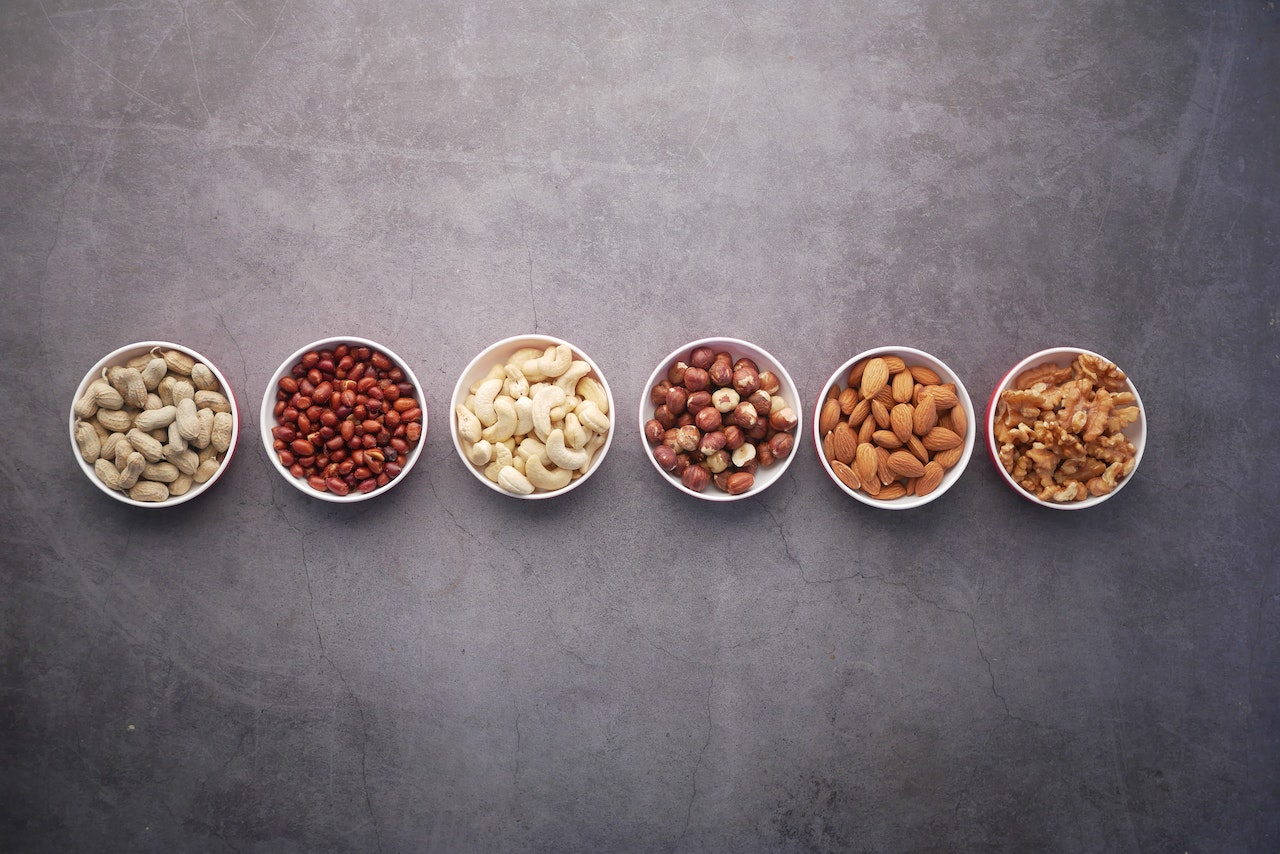Top 6 Nuts For Protein Content
The word nut refers to a wide range of products in the culinary sense. Basically, nuts are dry edible fruits or seeds with high fat content. They are also defined as the seed kernels that are widely used in cooking eaten raw as snacks. They are generally rich in protein and fat, and many vegans eat nuts as a major source of protein in their diet. The following are the some most consumed nuts throughout the world:
- Almonds
- Walnuts
- Pistachios
- Pecans
- Hazelnuts
- Cashews
- Brazil nuts
- Macadamia nuts
- Pine nuts

Nuts are an excellent source of protein. They are tasty and can be enjoyed on all kinds of diets. Nuts can actually provide a similar amount of protein compared to meat, fish and poultry. They can be eaten raw, roasted or pressed for oil. They are also used in baking and cooking. The consumption of nuts dates back to prehistoric times. They have been an important source of nutrients for humans for a long time. They are enjoyed by many people mainly because of their taste, nutritional quality and manifold health benefits.
Benefits Of Consuming Nuts
Despite their high fat content, nuts have manifold health benefits. Some of the impressive health benefits of consuming nuts and nut products are mentioned below:
- Nuts are highly nutritious food items. 28 grams of mixed nuts contain about 173 calories, 5 grams of protein, and 16 grams of fat. They generally have lower amounts of carbohydrates, so they are considered an excellent food to eat on a low carbohydrate diet.
- Nuts are a rich source of antioxidants. Different types of antioxidants can be found in nuts, including polyphenols, which can be useful for overcoming oxidative stress by neutralizing the free radicals. Researchers have found that antioxidants present in walnuts and almonds can prevent fats in cells from being damaged.
- May increase the rate of weight loss. Despite being high calorie food, nuts may help you to lose weight. People consuming nuts are found to lose an average of 2 inches from their waists as compared to people consuming olive oil both following the Mediterranean diet.
- Lower the blood cholesterol level. Nuts are supposed to lower the blood cholesterol level. Nuts lower the blood cholesterol level due to the presence of monounsaturated and polyunsaturated fatty acids. One study conducted in women proved that women consuming 30 grams of walnuts, peanuts and pine nuts per day for 6 weeks significantly lower all types of cholesterol.
- Reduce the risk of Type-2 diabetes and metabolic syndrome. Type-2 diabetes is common throughout the world. Metabolic syndrome refers to the group of risk factors that may increase the risk of heart disease, stroke and type-2 diabetes. Hence, type-2 diabetes and metabolic syndrome are strongly linked. Nuts are low in carbohydrates, hence they do not increase blood sugar levels much. Consumption of nuts often leads to reduced blood sugar levels.
- Reduce the risk of inflammation. Nuts possess anti-inflammatory activities. Inflammation refers to the body’s way of defending itself from injury, bacteria and other possible pathogens. Long term inflammation can damage your organs. Nuts like walnuts, Brazil nuts and almonds reduce the risk of inflammation.
- Rich source of beneficial fiber. Nuts are also a rich source of fiber. Fiber has many health benefits. Fiber is not easily digested by our body. Bacteria present in the colon play an important role in fiber digestion. Many fibers are the source of food for gut bacteria.
Top 6 Protein-Heavy Nuts
The following are the top 6 nuts for protein content:
1. Almonds
Botanically, almonds are drupe fruit native to the Mediterranean region. More than 30 different varieties and eight types of almonds are also grown in California. About 1 gallon of water is required to produce a single almond. After extracting the seed, the hulls and shells of almonds are often used to feed livestock. Almonds are a rich source of vitamin E, monounsaturated fatty acids, fiber, biotin, minerals like calcium, phosphorus, and magnesium, and phytonutrients like flavonoids, plant sterols, and phenolic acids. One ounce of almonds provides about 165 calories, 6 grams protein, 14 grams fat (out of which 80 percent is monounsaturated), 6 grams carbohydrate and 3 grams fiber. Almonds are highly beneficial for health! They reduce the risk of heart diseases and have anti-inflammatory properties. Also, they have antioxidant effects.
2. Pistachios
Pistachios one of the oldest nuts in the world. Humans ate pistachios as early as 7,000 B.C. Pistachios are the seeds of the pistachio tree. The kernel of a pistachio seed has different colors that may vary from yellow to shades of green. Pistachios have higher levels of unsaturated fatty acids compared to other nuts. They also have anti-inflammatory and antioxidant properties that are generally beneficial for health. They are useful for keeping blood sugar and blood pressure levels to a safe threshold. 1 ounce of Pistachios provides about 159 calories, 5.72 grams of protein, 7.7 grams of carbohydrate and 12.85 grams of fat. Pistachios are great sources of vitamins and minerals including manganese, phosphorous, copper, and vitamin B6.
3. Cashews
These are the kidney shaped seeds obtained from the cashew tree. Cashew is a tropical tree native to Brazil. Raw cashews are not safe to eat as they contain a toxic substance known as urushiol that can trigger skin reaction in some people. Generally, cashew kernels are cooked to remove this toxic liquid and only then they are marketed. Like other nuts, cashews are highly beneficial for your health. Cashew consumption is associated with weight loss, controlled blood sugar level and reduced heart related diseases. One ounce of cashews can provide about 157 calories, 5 grams protein, 12 grams Fat, 9 grams carbohydrates and 1 gram fiber. They are also a good source of vitamin K and vitamin B6. Cashews contain minerals like copper, magnesium, manganese, zinc, phosphorus, selenium and iron.
4. Hazelnuts
The fruits of the hazel tree are called hazelnuts. Hazel trees have round fruit which is pointed at one end. Hazelnuts are sweet in taste and possess a fibrous tone. Fibertone is the naturally occurring ketone found in hazelnuts. One ounce of hazelnuts provide about 176 grams of calories, 17 grams total fat, 4.2 grams protein, 4.7 grams carbohydrates and 2.7 grams fiber. Magnesium, copper and manganese are the important minerals found in hazelnuts. They are also a good source of vitamin E. Antioxidants present in hazelnuts are good for health. Studies have shown that hazelnuts can also reduce cholesterol levels in the body and help prevent cancer.
5. Chestnuts
Chestnuts are more similar to fruits than true nuts. They consist of spiny husks and a dark brown shell. Both of them must be removed before eating. Chestnuts are low in fat content but are a rich source of vitamin C. They have been used as a food source for thousands of years. Unlike other nuts, they do not contain many calories. However, they are a good source of amino acids, vitamin C, antioxidants, phenols and monounsaturated fatty acids. Vitamins A, E, B complex and C are found in chestnuts, as well as minerals like calcium, magnesium, zinc, iron, copper and manganese. One serving of roasted chestnuts contains about 205 calories, 2.7 grams of protein, 1.9 grams of fat, 44.5 grams carbohydrates, and 4.3 grams of fiber.
6. Macadamia nuts
Macadamia nuts are tree nuts. It is native to Australia. Like other nuts they are also rich in nutrients. They improve digestion, improve heart health, weight management and reduce blood sugar level. One ounce of macadamia nuts provides about 204 calories, 23 grams fat, 2 grams protein, 4 grams carbohydrates, 1 gram sugar and 3 grams fiber. Minerals like manganese, copper, magnesium and iron are also found in this nut. It is also a good source of Vitamin B6. They are also rich in monounsaturated fatty acids. Due to the presence of monounsaturated fatty acids, macadamia nuts can boost heart health.
Conclusion
Nuts are a rich source of nutrients. Basically, nuts are edible fruits with high nutrient content that are very beneficial for our health. They are a rich source of vitamins, minerals, proteins and fat. Despite their high fat content, they are a healthier alternative to many processed foods. Consuming nuts has manifold benefits to human health, such as reduced risk of heart related diseases, reduced risk of type-2 diabetes, and lower blood cholesterol levels. Almonds, cashews, pistachios, macadamia nuts, hazelnuts, and chestnuts are the nuts with highest protein content. Eat a handful daily for a happier, healthier life!

